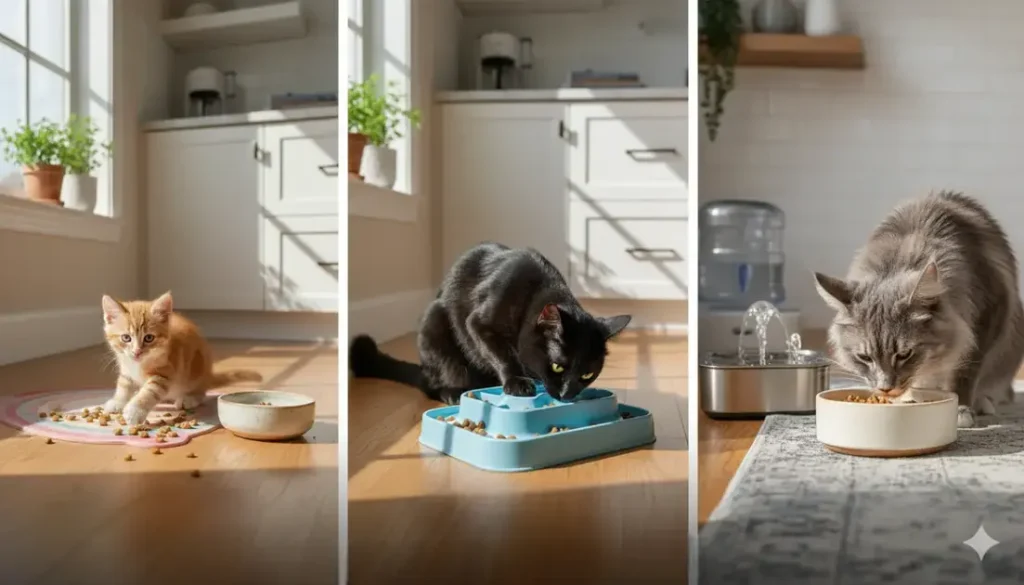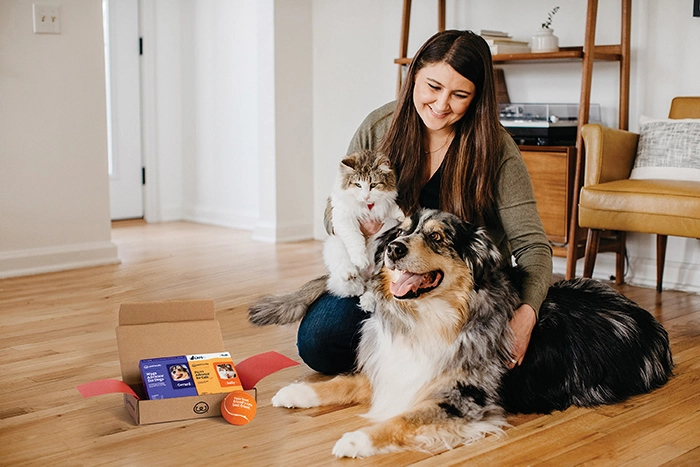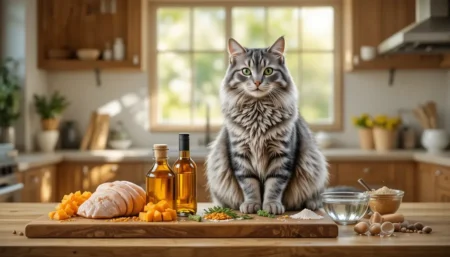Cat nutrition by life stages means feeding your pet food formulated for their specific age: kittens need calorie-dense, high-protein diets for growth, adult cats require balanced maintenance nutrition, and seniors benefit from formulas that support kidney health and joint mobility.
Feeding the right food at the right time prevents obesity, extends lifespan, and reduces disease risk. Understanding these changing needs helps you make informed decisions at every phase of your cat’s life. Here’s exactly what to feed from the first year through the golden years.
Why Cat Nutrition by Life Stages Matters for Healthy Development
Feeding the same food throughout your cat’s life is like feeding a toddler the same diet as a retiree—it simply doesn’t meet their changing biological needs. Cats experience dramatic metabolic shifts as they age, and their nutrition must adapt accordingly.
Life-stage feeding is supported by decades of veterinary research. The Association of American Feed Control Officials (AAFCO) establishes specific nutrient profiles for “growth and reproduction” (kittens and pregnant cats) and “adult maintenance.”
These aren’t marketing labels—they’re scientifically validated standards ensuring your cat gets precise nutrient ratios for their developmental phase.
Getting it right matters. Improper nutrition contributes to 60% of adult cat obesity cases, while senior cats fed age-appropriate diets show 30% slower progression of chronic kidney disease. The right food at the right time is preventative medicine.
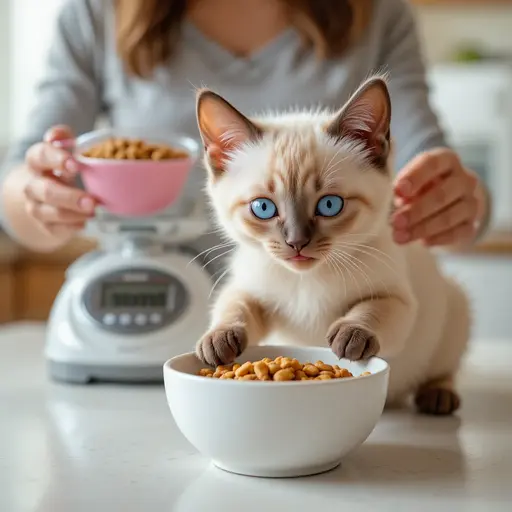
Kitten Nutrition (0-12 Months)
Kittens grow from a one-pound newborn to a 10-pound adult in under a year—that’s a tenfold increase requiring extraordinary nutritional support. This stage demands the most calorie-dense, nutrient-rich diet of any life stage.
Calorie and Protein Requirements
Kittens need twice the calories per pound of body weight compared to adult cats. They also require 30-40% protein (dry matter basis) minimum, with at least 11% from animal sources.
This isn’t negotiable—insufficient protein during development can permanently stunt growth and impair organ development.
Look for foods labeled “complete and balanced for growth and reproduction per AAFCO standards.” The first ingredient should be a named meat source (chicken, turkey, salmon), not a by-product or grain.
DHA, an omega-3 fatty acid, is crucial for brain and vision development—quality kitten foods include fish oil as a source.
Practical tip: Free-feed kittens under four months old. Their stomachs are tiny and can’t hold enough food for three square meals. Keep dry kitten food available 24/7, supplemented with three to four small meals of wet food daily.
Wet vs. Dry Food for Kittens
Both have merits, but wet food is particularly valuable during this stage. Kittens transitioning from mother’s milk often refuse dry kibble. Wet food’s 75-78% moisture content prevents dehydration and eases kidney workload during rapid growth.
That said, dry kibble’s convenience and dental abrasion benefits make it worth including. The ideal approach: offer a high-quality dry kitten food free-choice, plus measured portions of wet food three times daily. This combination supports hydration while encouraging healthy chewing habits.
When shopping, choose kitten-specific formulas with smaller kibble sizes. Large pieces can be difficult for tiny mouths to manage and may deter eating.
Feeding Schedule by Age
- 6-12 weeks: Four meals daily. Mix wet food with warm water to create a gruel if the kitten struggles with texture.
- 3-6 months: Three meals daily. Free-feed dry food, but measure wet portions to prevent overfeeding.
- 6-12 months: Transition to two meals daily. Begin reducing free-feeding if your kitten shows signs of pudginess.
Red flag: If your kitten isn’t gaining 0.5-1 ounce daily or seems lethargic, consult your vet immediately. Hypoglycemia is dangerous in young kittens.
Adult Cat Nutrition (1-7 Years)
The adult stage is the longest and most stable phase of your cat’s life. The goal shifts from growth to maintenance and disease prevention, particularly obesity.
Maintenance Nutrient Needs
Adult cats require 25-30% protein and moderate fat levels (9-15%). Calories should match activity level—a moderately active 10-pound cat needs roughly 200-250 calories daily. Indoor cats typically need 20% fewer calories than outdoor cats due to lower activity.
The most critical factor? Portion control. Free-feeding adults leads to weight gain in 70% of cases. Instead, measure meals using a digital scale, not a scoop. One extra tablespoon of dry food daily can cause a one-pound weight gain per year.
When selecting adult food, prioritize formulas with named meat as the first ingredient and minimal fillers like corn or soy. Look for guaranteed analysis showing taurine levels (minimum 0.1%)—this amino acid is non-negotiable for heart and eye health.
Wet vs. Dry Food Debate for Adults
This controversy divides cat owners, but the data is clear: wet food better supports long-term health.
Wet food’s high moisture content (75-80%) mirrors a cat’s natural prey-based diet. Cats have a low thirst drive and often exist in a state of chronic mild dehydration on dry-only diets, stressing their kidneys. Long-term studies show cats fed wet food have 50% lower rates of chronic kidney disease.
However, dry food has legitimate advantages: cost-effectiveness, convenience, and dental tartar reduction. The mechanical action of crunching kibble scrapes plaque.
Best practice: Feed at least 50% of your adult cat’s calories from wet food. If feeding dry, invest in a pet water fountain—cats drink more from moving water sources.
Preventing Obesity in Prime Adult Years
Adult cats are most prone to weight gain between the ages of 2-6. Implement these strategies:
- Feed meals, not free-choice: Two measured meals daily.
- Use puzzle feeders: These slow eating and provide mental stimulation.
- Calculate treats: Treats should never exceed 10% of daily calories. A single large dental treat can be 15 calories—significant for a 10-pound cat.
- Body condition scoring: You should feel your cat’s ribs without pressing hard and see a visible waist from above.
Consider a slow-feeder bowl if your cat eats too quickly and vomits. These bowls have ridges that force cats to eat around obstacles, reducing scarf-and-barf incidents.
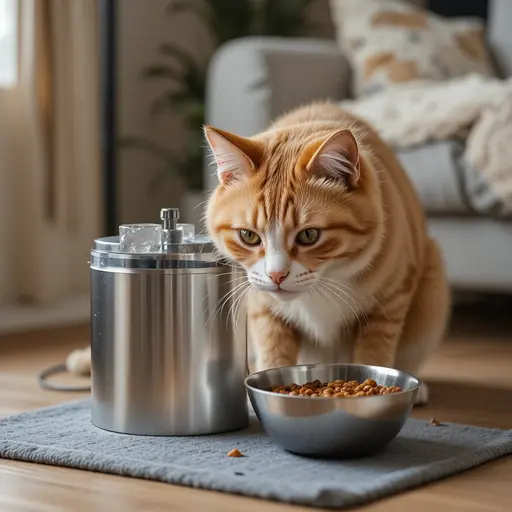
Mature Adult Nutrition (7-10 Years)
This often-overlooked stage is when subtle metabolic changes begin. Your cat isn’t a kitten, but isn’t yet “senior.” Think of it as preventative senior care.
Early Age-Related Changes
Around age seven, metabolic rate decreases 10-15%, and muscle mass gradually declines. Kidney function may begin diminishing, though blood work often appears normal. This is the ideal time to shift to a “mature adult” or “indoor 7+” formula.
These transitional formulas typically feature:
- Slightly reduced calories (10% less) to offset slower metabolism
- Increased fiber for digestive health
- Added antioxidants (vitamin E, beta-carotene) to combat cellular aging
- Moderate phosphorus levels to reduce kidney strain
Actionable step: Schedule a senior wellness exam at age seven, including blood work. This establishes a baseline to track future changes.
Senior Cat Nutrition (10+ Years)
Senior cats have distinct nutritional needs focused on managing chronic disease, preserving muscle, and maintaining appetite.
Addressing Age-Related Health Issues
The most common senior cat conditions—chronic kidney disease (CKD), arthritis, and hyperthyroidism—are all influenced by diet.
Chronic Kidney Disease Management: CKD affects 50% of cats over 15. The cornerstone of dietary management is restricted phosphorus (0.3-0.6% dry matter) and moderate protein (28-35%). Lower phosphorus slows disease progression, while adequate protein prevents muscle wasting.
Prescription renal diets exist, but some senior formulas offer moderately reduced phosphorus without requiring a prescription. Always consult your vet before switching to a therapeutic diet.
Joint Support: Arthritis is painful and reduces mobility, which leads to weight gain. Look for foods with added glucosamine (500-800 mg/kg) and omega-3 fatty acids from fish oil (EPA/DHA). These supplements reduce inflammation and improve joint function.
Appetite Decline: Senior cats often eat less due to a decreased sense of smell or dental pain. Warming food to body temperature (100°F) amplifies aroma and stimulates appetite. Offering multiple small meals throughout the day can also help.
Protein: The Senior Paradox
While kittens need maximum protein, seniors need high-quality, highly digestible protein. Their aging kidneys process protein less efficiently, but insufficient protein causes rapid muscle loss (sarcopenia).
The solution: Feed 28-35% protein from named animal sources, not plant proteins. Senior-specific formulas balance these needs. Avoid generic “adult” foods with lower protein content.
Hydration Becomes Critical
Senior cats with CKD can’t conserve water effectively. Wet food is non-negotiable for seniors, providing essential moisture without requiring drinking. Offer fresh water in multiple locations, including wide, shallow bowls that don’t whisker-fatigue your cat.
Consider a pet water fountain. The movement attracts cats and encourages drinking, which is crucial for kidney function.
Special Considerations Across All Life Stages
Food Allergies and Sensitivities
Food allergies can develop at any age. Symptoms include chronic itching, ear infections, and vomiting. Common culprits are chicken, beef, dairy, and fish.
If you suspect allergies, conduct an elimination diet using a novel protein (rabbit, duck, or venison) for 8-12 weeks. Hydrolyzed protein diets are another option—the proteins are broken down so small that the immune system doesn’t react.
Dental Health Connection
Dental disease affects 70% of cats by age three. While dry food helps reduce tartar, it’s not a substitute for brushing. Dental treats and water additives can help, but the mechanical action of chewing raw chicken necks (under supervision) provides superior cleaning.
For cats who won’t tolerate brushing, consider a prescription dental diet. These kibbles are engineered to shatter in a way that scrapes teeth clean.
Hydration Station Strategies
Cats naturally have low thirst drives, evolved from desert-dwelling ancestors. This makes strategic hydration essential at every stage:
- Kittens: Wet food gruel ensures adequate fluid intake
- Adults: Multiple water stations, fountain encouraged
- Seniors: Wet food primary diet, add water to kibble if necessary
Add a tablespoon of water to wet food to boost hydration further. For picky cats, low-sodium chicken broth (no onions/garlic) can entice drinking.
Common Feeding Mistakes to Avoid
- Feeding dog food to cats: Cats require taurine, arachidonic acid, and preformed vitamin A—nutrients that dogs can synthesize. Dog food causes severe deficiencies.
- Raw food without vet supervision: Raw diets can be nutritionally balanced, but risk bacterial contamination and parasite transmission. Never feed raw without veterinary-formulated recipes.
- Ignoring calorie density: A cup of Food A might be 300 calories, while Food B is 500 calories. Always check the label and adjust portions.
- Over-supplementing: Adding vitamins to a complete diet can cause toxicity, particularly with fat-soluble vitamins A and D.
- Sudden diet changes: Always transition over 7-10 days to avoid gastrointestinal upset.
How to Transition Diets in Cat Nutrition by Life Stages
Changing foods requires patience. Cats are neophobic (fearful of new things), and sudden switches cause vomiting, diarrhea, and food rejection.
The 10-Day Transition Protocol:
- Days 1-3: Mix 25% new food with 75% old food
- Days 4-6: Mix 50/50
- Days 7-9: Mix 75% new food with 25% old food
- Day 10: 100% new food
If your cat refuses the new food, slow down. Some cats need 2-3 week transitions. Warm the food slightly and add a teaspoon of the old food on top as “bait.”
Special note for seniors: Older cats with compromised health may need even slower transitions. If your senior cat eats poorly, prioritize their eating anything over transitioning perfectly.
Your Cat Nutrition Timeline
Birth-12 months: Kitten formula, free-feed dry, 3-4 wet meals daily. Focus on growth and DHA for brain development.
1-7 years: Adult maintenance formula, measured meals twice daily. Aim for 50%+ calories from wet food. Prioritize portion control and obesity prevention.
7-10 years: Mature adult or indoor 7+ formula. Reduce calories by 10%. Increase antioxidants. Schedule a senior wellness screening.
10+ years: Senior-specific formula with restricted phosphorus, added joint support, and maximum wet food intake. Monitor appetite and weight closely. Work with your vet to manage chronic conditions.
Frequently Asked Questions
How do I know if my cat is getting the right nutrition?
Monitor these key indicators:
- Body condition: Visible waist, palpable ribs with slight fat cover
- Energy level: Appropriate for age (kittens hyperactive, seniors more sedate)
- Coat quality: Shiny, minimal dandruff, minimal shedding
- Stool quality: Firm, well-formed, not overly smelly
- Annual vet checks: Blood work reveals deficiencies before symptoms appear
If your cat scores well on these points, their nutrition is likely adequate.
Can I feed all my cats the same food if they’re different ages?
No, this is strongly discouraged. Kittens eating adult food won’t grow properly. Adults eating kitten food will become obese. Seniors eating adult food miss critical kidney support.
The only exception: some high-quality “all life stage” formulas exist, but they must meet AAFCO standards for growth and maintenance. Even then, portion control becomes critical, and seniors often need supplementation. It’s simpler and healthier to feed separately.
When should I switch to senior cat food?
Most cats benefit from transitioning to senior formulas between ages 7 and 10. The exact timing depends on:
- Breed: Larger breeds (Maine Coons) age more slowly and may switch later
- Health status: If early kidney changes appear on blood work, switch immediately
- Activity level: Very active 10-year-olds might stay on adult food longer
Discuss timing with your vet during annual wellness exams. Early intervention with senior diets slows disease progression significantly.
Is grain-free better?
Not necessarily. The grain-free trend was driven by canine concerns, not feline needs. Cats can digest properly processed grains, and grain-free foods often substitute with peas or potatoes, which have been linked to heart disease (DCM) in some studies.
Focus on high-quality animal protein rather than avoiding grains. The exception: if your cat has a confirmed grain allergy (rare), then grain-free is appropriate.
How many treats are too many?
Treats should comprise no more than 10% of daily calories. For a 200-calorie/day cat, that’s 20 calories from treats—about 10 small commercial treats or one tablespoon of tuna.
Over-treating unbalances the carefully formulated diet and trains cats to hold out for tastier options. Use treats strategically for training, medication administration, or bonding—not as meal replacements.
Conclusion
Understanding cat nutrition by life stages transforms feeding from a chore into a powerful act of preventative care. The right food at the right time prevents obesity, extends healthy years, and reduces suffering from chronic disease.
From the protein-packed density kitten formulas to the kidney-supporting, joint-cushioning recipes for seniors, each stage has specific needs that your choices can meet.
The most important takeaway? Don’t wait for problems to appear. Proactive nutrition—switching to mature adult food at age seven, prioritizing wet food for hydration, and measuring every meal—keeps your cat thriving longer. Small, consistent actions compound into years of extra health.
Your cat depends on you to make these decisions. With the knowledge from this guide, you’re equipped to choose wisely, avoid common pitfalls, and adapt as your cat ages.
Remember: annual veterinary checkups with blood work are the foundation that validates your nutrition strategy.





